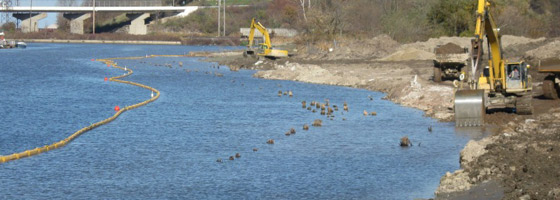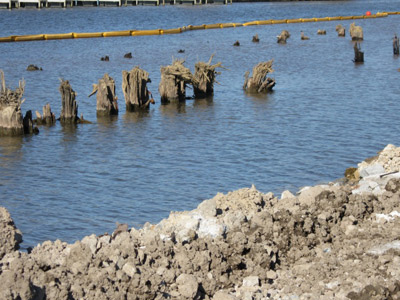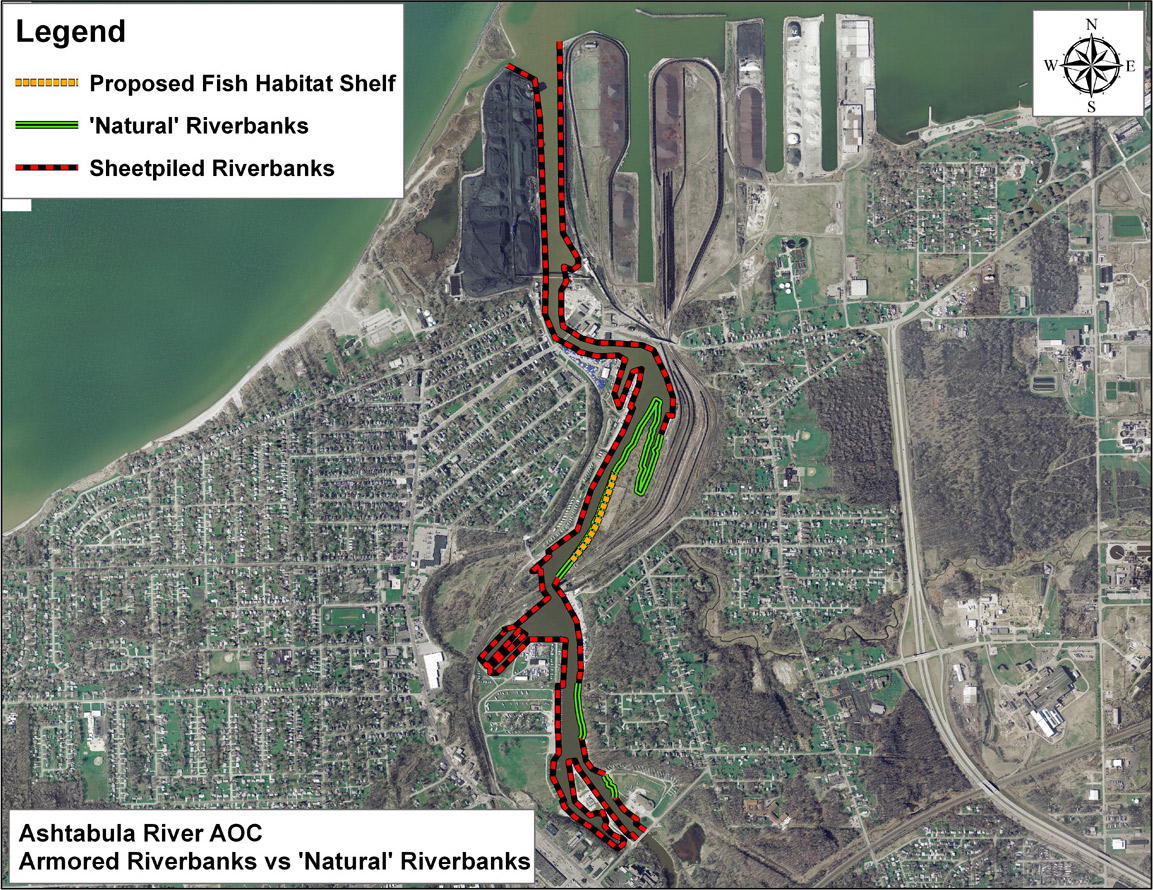Restoring the Ashtabula

The Ashtabula River may soon be off the list of the EPA’s areas of concern (AOC), thanks to the efforts of a 23-year remediation project that is nearly complete. The last stage will create nearly half a mile of fish shelf habitat in the middle of the 2-mile Ashtabula River AOC, known as the 5 ½ Slip site. The project should be completed by summer 2012, according to the Ohio EPA.
Originally christened by the Iroquois as “river of many fish” the Ashtabula has been mismanaged and polluted for the last 70 years. The river’s sensitive aquatic ecosystems were damaged by unregulated chemical discharge from World War II ship building and industrial waste in the latter part of the 20th century. As a result, all recreational activities were halted in the lower portion of the river. In 1988, the Ohio EPA helped form the Ashtabula River Remedial Action Plan Advisory Council, which oversees  improvements to the AOC. The council found six beneficial use impairments in the Ashtabula River AOC, including degradation of fish populations, loss of fish habitat, fish tumors and deformities and restrictions on fish consumption.
improvements to the AOC. The council found six beneficial use impairments in the Ashtabula River AOC, including degradation of fish populations, loss of fish habitat, fish tumors and deformities and restrictions on fish consumption.
The 5 ½ Slip site is a channel that ends on land and was used as a place to demolish old freighter ships. Because it is not fully connected to the river, the area has no water current and low dissolved oxygen levels. When the river was first designated as an AOC, many of the fish had deformities due to polluted, stagnant water.
“They were finding tumors, particularly on the bullheads,” said Fred Leitert, chairman of the Advisory Council. “We had fish that were sick, that’s for sure.”
The restoration project will connect the slip back to the river to restore water currents and life-supporting oxygen levels. Upstream of the AOC, the watershed is designated as a State Scenic River where northern pike, muskellunge and largemouth bass flourish. These fish populations, coveted by fly fishermen, could begin to spawn downstream in the restored habitat. It will also provide a resting place for migrating steelhead trout, opening up recreational opportunities for locals and visitors alike.
“It’s a healthy river and people come from all over the United States and Canada to fish for steelhead trout,” Leitert said.
Despite the overall health of the river, the 2-mile stretch identified as an AOC contained deposits of chemical waste. In 2007 the Great Lakes Legacy Act (GLLA), a federal program founded to clean sediment in AOCs, funded dredging that extracted nearly 500,000 cubic yards of contaminated sediments. The next year, the Water Resource and Development Act sponsored a second dredging, removing another 130,000 cubic yards of sediment. An estimated 25,000 pounds of PCBs were removed, along with uranium, radium and thorium.
Chemical hazards were not the only obstacle to restoration of the fish habitat. The Ashtabula River was originally used as a port for coal cargo ships which, over time, ruined the slope of the riverbank. The sharp drop-offs of the banks stood in contrast to the gradual slopes fish need to spawn. Leftover funding from the GLLA allowed for the construction of more than 800 feet of fish habitat shelf last year. Another 1,500 feet of habitat shelf will be completed in the summer of 2012 thanks to a $1.5 million grant from the Great Lakes Restoration Initiative. The restored riverbank slope provides a shallow area suitable for spawning.
“We are nearly tripling the amount of constructed habitat in the Area of Concern and expect it will result in significantly improved fish populations,” said Ohio EPA director Scott Nally in a news release.
According to the the RAP Advisory Council, when finished, the restoration plan will create 2,700 feet of fish habitat shelf and four acres of wetlands for local birds and mammals.
The RAP Advisory Council expects the 5 ½ Slip site restoration will put the Ashtabula River AOC closer to delisting status. In order to be removed from the AOC list, a site must first resolve each beneficial use impairment, and the 5 ½ Slip section alone will have a significant impact on that assessment.
To be delisted for loss of fish habitat, Ashtabula River AOC will need a qualitative habitat evaluation index (QHEI) score of 60 or higher and a Lake Erie QHEI score of 55 or higher. The Ohio EPA developed the QHEI as a measure of fish habitat quality based on physical factors in the ecosystem. The QHEI gives a score to six different parameters including water flow and erosion. With the new fish habitat shelves, the Advisory Council expects a Lake Erie QHEI score of at least 70, allowing the AOC to be delisted for degradation of fish habitat.
Leitert and other Advisory Council members know that when this project is finished, there will be more habitats to create and other aquatic areas to improve. However, Leitert has enjoyed the success of the Ashtabula River restoration from the seat of his own bass boat that he bought last summer.
“Looks like a turnaround in fish,” he said. “ We feel that we have done a sufficient amount of work.”
Image credits: Kristopher Weiss, Public Involvement Coordinator with the Ohio EPA Public Interest Center




0 comments